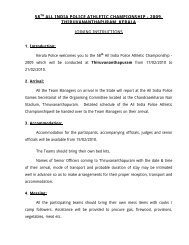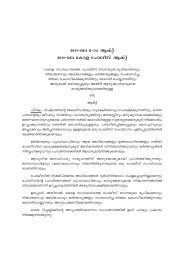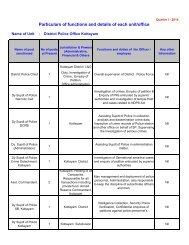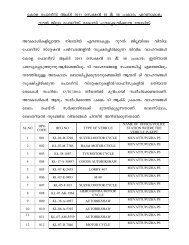Janamaithri Suraksha Project - Kerala Police
Janamaithri Suraksha Project - Kerala Police
Janamaithri Suraksha Project - Kerala Police
You also want an ePaper? Increase the reach of your titles
YUMPU automatically turns print PDFs into web optimized ePapers that Google loves.
eviewing and issuing clarifications are meant to ensure that the ‘intent’ and ‘design’ of the policy<br />
conforms to the implementation. A senior police officer may be appointed as State Level Nodal<br />
Officer for such purpose and continue for a sufficiently longer tenure.<br />
Internal marketing: Bulk of police leadership including the middle management are sceptical of<br />
the community policing initiatives on two counts, firstly the tendency among police officers to<br />
‘resist the intrusions of civilian into their business’ and secondly to ‘look down upon community<br />
policing measure as going soft and futile exercise’. Many of them are prone to attribute reasons to<br />
the scheme for any rise in crime statistics, citing diversion of manpower to ‘non-core’ police activities.<br />
It requires good deal of efforts by the police leaders on internal marketing to overcome such mindset.<br />
‘Community Policing’ as a subject may be included in the police training syllabus.<br />
Legal & institutional framework: The police mission statement needs to be redefined with<br />
community policing as one of its core objectives. The new <strong>Police</strong> Act to be legislated or under<br />
process of legislation by the state governments on the basis of directives from the Supreme Court<br />
should incorporate community policing practices within the Act to acquire legitimacy as a legislative<br />
policy. A state level training and resource centre may be established to institutionalise the planning,<br />
coordination, research and training activities.<br />
Resource Planning: Government must provide budgetary support for undertaking various activities<br />
under the community policing scheme. The additional manpower and other logistics support should<br />
be committed by the government. The police organisation must be prepared to successfully run<br />
the pilots out of its own resources till the spread effects are felt by the communities which in turn<br />
act as pressure groups for demanding resource augmentation from the government.<br />
Social Audit & Research: The impact and outcome analysis of the project should be periodically<br />
conducted through competent third party institutions and the feedback acted upon for course<br />
correction, if necessary. Internal and external research by police practitioners and academics<br />
should be encouraged to modify and improvise on existing practices.<br />
Herring-bone policy model: An overarching community policing scheme with ‘beat police officer’,<br />
‘community liaison group’, ‘citizen volunteers’ and ‘district advisory committee’ may be adopted for<br />
its wide sweep and scope. Other target specific schemes for students, senior citizens, women,<br />
slum-dwellers, juveniles in conflict with law should supplement the overarching model like herringbone<br />
structure as scaffoldings.<br />
<strong>Janamaithri</strong> <strong>Suraksha</strong> <strong>Project</strong> vis-a-vis the National Overarching Model on Community<br />
Policing: ‘<strong>Police</strong> Community Partnership’, the national overarching model, drafted by the members<br />
of Micro-mission-II of the National <strong>Police</strong> Mission, MHA, government of India, of which the author is<br />
a member, and the <strong>Janamaithri</strong> <strong>Suraksha</strong> <strong>Project</strong> (JSP), the flagship community policing scheme<br />
of <strong>Kerala</strong> police are both three-tier structures with the beat police as the mainstay. But policy<br />
makers of JSP have gone a step ahead with introduction of ‘house visit’ by the beat or community<br />
police officer to get him acquainted with the members of the public. It had made all the differences<br />
to the outcome of the policy processes: trust level between police and public has increased, overall<br />
sense of security of the public has gone up, members of the community and frontline police officers<br />
feels empowered. The author as Chairman of the Committee on implementation of community<br />
policing in the state of Odisha has drafted a policy outline, ‘Ama <strong>Police</strong>’ along the line with that of<br />
JSP having regard to the tangible outcomes it has shown during the field study.<br />
1.8 Suggestions for Further Research The field research of <strong>Janamaithri</strong> <strong>Suraksha</strong> <strong>Project</strong>, the<br />
flagship community policing scheme of <strong>Kerala</strong> police, was conducted in the fourth year of its<br />
launching, a relatively smaller span of time to assess the outcomes which are mostly tangible in<br />
long term. Further study on police and community empowerment, change in organisational behaviour,<br />
impact of JSP on police accountability and transparency will throw interesting insight into the impact<br />
of the policy. The JSP as a doable model could be replicated in other states of the country. But,<br />
<strong>Kerala</strong> is different from many other Indian states with highest rate of literacy and life expectancy,<br />
higher urbanisation and per capita income. Will the states or districts with same level of socioeconomic<br />
growth or similar Human Development Index be able to replicate similar scheme at<br />
ease with contexts remaining the same A national policy mapping on community policing may<br />
give the answer to such query by further research.<br />
This study is part of Dissertation by the author for two years PGPPM Course<br />
(2011-13) at IIM, Bangalore. He is an Odisha cadre officer.<br />
19

















